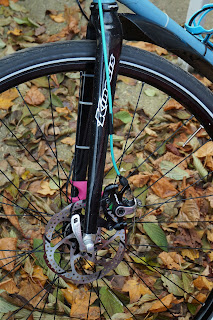The wintry weather gave way to
the misty, mild and occasionally blustery stuff, typical of these shores around
Christmas. Given the recent postal pilfering, I was relieved to return from a
wet and greasy ride to discover a box of contraband had been taken in by a
neighbour.
Unfortunately,
a series of diplomatic incidents instigated by my elderly and very malevolent
feline hastened their retrieval. This package came from Interloc Racing
Design (IRD) http://www.interlocracing.com/
These are their CAFAM II
cantilevers, which I had earmarked for the Univega. A classic wide arm design,
sometimes described as MAFAC pattern. Their beautifully polished, CNC machined
arms offer vastly superior mechanical advantage compared with modern, low
profile types.
Look a little closer and
you’ll notice they’re actually a marriage of retro and contemporary. Yes,
there’s the old school cable anchor (which tightens via 10mm nut) less
convenient, dare I say sleek, than modern Allen key patterns but effective
nonetheless.
Yokozuna Cartridge Brake Shoes (Scott-Mathauser Gen-X
salmon compound) are another force to be
reckoned with and a doddle to setup.
That said; getting
modulation and feel bang on proved trickier than I was expecting. Part of this
was down to my brain engaging “M system default” but the combination of moustache bars and shorter
reach Microshift brifters can also present minor challenges. If adjustment
isn’t exacting, the brake lever will, more or less, touch the bars when engaged
with any conviction.
On the subject of brake
levers, ten years ago, I ran a similar configuration with Dia Compe V brake
specific levers. Purely to see, just how dangerous, or otherwise the
combination was.
Firstly, I DO NOT RECOMMEND
THIS PRACTICE. Simply put, using a V brake lever with a cantilever is the
fastest way to pitch yourself over the bars, or lock the rear wheel.
With the Dia Compe, anything
more than a faint caress of the lever raised the rear wheel several inches off
the ground. Lesson learned.
The other word of caution
concerns wide arm cantilevers and smaller frames.
Broader arms can catch heels
and in some instances, foul racks/panniers. I may even substitute the On-One
cantilevers for the Avid that were formerly up front, next time cable
replacement calls. Meantime, I’ll switch over to the tubby tourer, variable
gears and of course, testing the IRD.
With this in mind, I’ve added
some “helicopter tape” around the top and head tube area. Rubberised cable
cuffs are a real boon but wet gritty stuff and Kevlar housings can still make
inroads into the paintwork. Yes, even properly applied powder coating.
I frequently talk about tyres
and tyre choice is particularly important during winter. Not only in terms of
contact but also puncture resistance. Tackling punctures when it’s cold and
dark is no fun.
With that in mind, Cross
inspired fixer and I were thwarted by a very aggressive thorn on Thursday
morning-I was already running a little behind schedule.
Having pulled over and
selecting a sheltered clearing, I opened unzipped the passport wedge pack. Tyre
levers, multi tool, cable ties…CO2 inflator…No tube…Patch kit, ummm. How did I
manage to leave a tube out!!!
Morale descending close to my
boots, I remembered the Upso Stirling https://www.sevendaycyclist.com/upso-stirling-seat-pack
nestling beneath those beefy drops.
Peeling back the zipper tags and reaching in, I found one, yes packet fresh and
ready to go. Phew! The miracle before Christmas had indeed materialised.
Thorn extracted, fresh butyl
and, 55psi in the Nordic spike, we were back in business. Now, some folks flat more than others but you
can never have too many tubes. If you’re stuck stocking-filler wise, for the
cyclist(s) in your life, tubes and Co2 inflators are good, practical bets…


















































